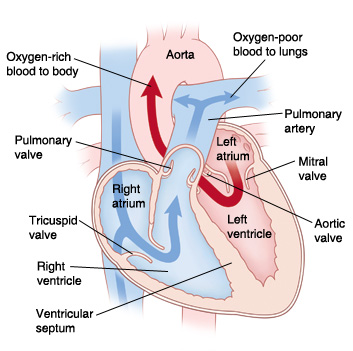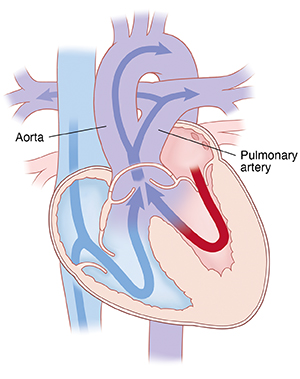Truncus Arteriosus (TA)
What is truncus arteriosus?
Truncus arteriosus is a heart defect that is present at birth (congenital). It happens when there is an abnormal connection between the aorta and pulmonary artery. Normally, the aorta and the pulmonary artery are separate. In truncus arteriosus, both the aorta and pulmonary artery begin from a common blood vessel.
Another congenital heart defect that nearly always happens with this condition is a ventricular septal defect (VSD). This is an abnormal hole in the wall (septum) between the two lower chambers of the heart (right and left ventricles).
In truncus arteriosus, oxygen-poor (blue) and oxygen-rich (red) blood mix through the VSD. The mixed blood that goes to the body does not have as much oxygen as it should.
 |
| Normal heart. |
 |
| Truncus arteriosus. |
What causes truncus arteriosus?
Some congenital heart defects may occur more often in certain families. These are called genetic defects. Truncus arteriosus is often seen in babies born with 22q11.2 deletion syndrome. But in most cases, the cause is not known.
What are the symptoms of truncus arteriosus?
Symptoms of truncus arteriosus include:
The symptoms of truncus arteriosus can be like other health conditions. Have your child see their healthcare provider for a diagnosis.
How is truncus arteriosus diagnosed?
A prenatal ultrasound may show truncus arteriosus. Your child's healthcare provider will check your child after birth. They may find signs like a pounding heart and weak pulse. They may hear an abnormal heart sound (heart murmur) when listening to your baby's chest with a stethoscope. If they do, you may have been referred to a pediatric cardiologist for a diagnosis. This is a healthcare provider with special training to diagnose and treat heart problems in babies and children.
These specialists will also examine your baby. They will listen to their heart and lungs with a stethoscope. Your baby may have other tests, including:
-
Pulse oximetry. A probe placed on your child's finger or toe can measure the oxygen level. Low levels may mean a diagnosis of truncus arteriosus.
-
Chest X-ray. This shows the overall size and shape of the heart and lungs. It may show signs typical of truncus arteriosus.
-
Electrocardiogram (ECG). An ECG records the electrical activity of the heart. It shows abnormal rhythms, and finds heart muscle stress.
-
Echocardiogram (echo). An echo uses sound waves (ultrasound) to make a moving picture of the heart and heart valves. An echo shows the truncus arteriosus.
-
Cardiac catheterization. This gives very detailed information about the structures inside the heart. Your baby will be given medicine to relax (sedation). The healthcare provider will put a thin, flexible tube (catheter) into a blood vessel in the groin. It is then moved to the heart. They will take measurements of blood pressure and oxygen in the heart chambers. The pulmonary artery and aorta will also be checked. Contrast dye is also injected to let the provider more clearly see the structures inside the heart.
How is truncus arteriosus treated?
Treatment will depend on your child’s symptoms, age, and general health. It will also depend on how severe the condition is.
Truncus arteriosus must be treated with surgery to fix the defects. Typically surgery needs to occur during the first few days or weeks of life. But your child may need medical support until it is time for the operation to take place. Support may include:
Nutritional support may include:
-
Special nutritional supplements. These may be added to formula or pumped breastmilk to increase calories.
-
Tube feedings. These are given through a small, flexible tube that passes through the nose, down the esophagus, and into the stomach. These feedings may be added to or take the place of bottle-feedings. Infants who can drink part of their bottles, but not all, may be fed the rest through the feeding tube. Infants who are too tired to bottle-feed may get their formula or breastmilk through the feeding tube alone.
Surgery is often done in the first few weeks after birth to prevent lung damage. The pulmonary arteries are separated from the aorta and reattached to the right ventricle. The pulmonary arteries may be reattached directly to the right ventricle typically using a conduit. The ventricular septal defect is also closed. Your child will stay in the hospital until after the surgical repair.
What are possible complications of truncus arteriosus?
If not treated, truncus arteriosus may cause complications, such as:
-
Lung damage
-
Heart failure
-
Infection of the lining of the heart and heart valves (bacterial endocarditis)
-
Poor growth and development
-
Diminished ability to function
-
Easily tired
-
Death
Living with truncus arteriosus
Soon after surgery, babies have more energy and start to eat better and gain weight faster. But your baby may need high-calorie formula for several weeks or months after surgery. Your baby may also need tube feedings until they are able to feed better.
Your baby may become tired easily, and sleep more right after surgery. But in a few weeks, they should be fully recovered.
You may get other instructions from your child's cardiac team and the hospital staff.
Most children who have had truncus arteriosus surgical repair will live healthy lives. Their activity levels, appetite, and growth will often return to normal. Talk with your child's cardiologist about what activities and sports are safe for your child.
Your child most likely will need more surgery and/or cardiac catheterization procedures as they grow. Surgery in young adulthood may also be needed. These surgeries may involve replacing valves, repairing a narrowed aorta or pulmonary arteries, or replacing conduits.
The cardiologist may advise that your child take antibiotics before surgery or dental procedures. This is to prevent infection in the lining of the heart and heart valves (bacterial endocarditis).
Your child will need regular follow-up care at a pediatric or adult congenital cardiac care center throughout life.
Talk with the cardiologist about your child’s outlook.
When should I call my child's healthcare provider?
Call your child's healthcare provider if your child has trouble breathing or feeding, or develops new symptoms.
Key points about truncus arteriosus
-
Truncus arteriosus happens when there is an abnormal connection between the aorta and pulmonary artery.
-
It causes oxygen-poor (blue) blood and oxygen-rich blood to mix and to be pumped to the body. This causes blue skin, lips, or nails (cyanosis).
-
The low levels of oxygen may not be enough to meet the body's needs and sustain life.
-
The condition must be treated with surgery. Most children who have surgery will live healthy lives.
-
Your child will need regular follow-up care with a pediatric cardiologist.
Next steps
Tips to help you get the most from a visit to your child’s healthcare provider:
-
Know the reason for the visit and what you want to happen.
-
Before your visit, write down questions you want answered.
-
At the visit, write down the name of a new diagnosis, and any new medicines, treatments, or tests. Also write down any new instructions your provider gives you for your child.
-
Know why a new medicine or treatment is prescribed and how it will help your child. Also know what the side effects are.
-
Ask if your child’s condition can be treated in other ways.
-
Know why a test or procedure is recommended and what the results could mean.
-
Know what to expect if your child does not take the medicine or have the test or procedure.
-
If your child has a follow-up appointment, write down the date, time, and purpose for that visit.
-
Know how you can contact your child’s healthcare provider after office hours. This is important if your child becomes ill and you have questions or need advice.